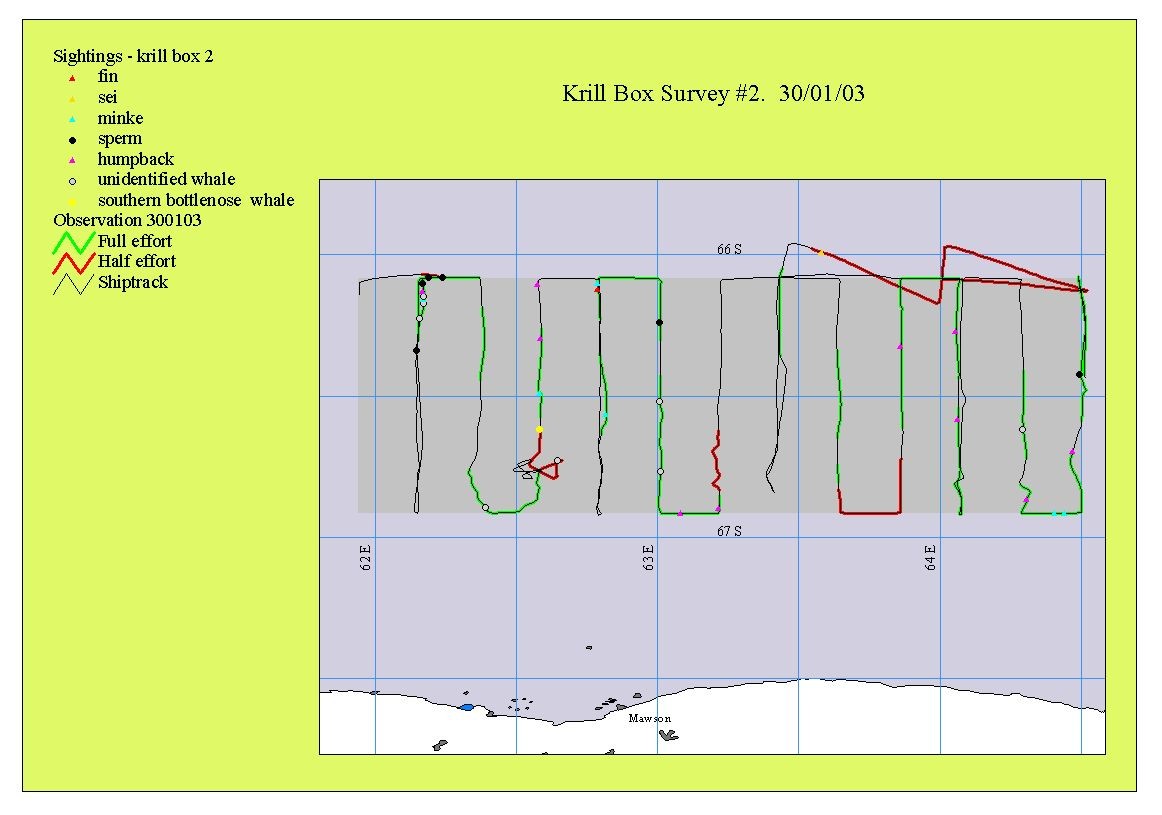Report #3: The Mawson Krill
Box – survey 2. (Map 3)
The
second survey of the Krill Box was primarily aimed at conducting a continuous
acoustic survey along the same track lines as the first survey, but moving from
west to east. Only 1.5 days were ‘lost’
to inclement weather, although several hours were completed on ‘incidental’
watch due to snow storms and resultant reduced visibility. The highlight of this transect was
undoubtedly a sperm whale that ‘popped up’ within 200m of the ship after his
>1000 m dive and provided all of us,
including the Voyage Leader (Dr. Steve Nicol),
the best view of this species to date.
The
FRC (Fast Rescue Craft) was launched to practice deployment of the boat and
some cross-bow work. This was completed
successfully with several direct hits at the target buoy: all systems ‘go’ for
biopsy sampling, collection of photographs suitable for photo-identification of
individual whales and whale faeces for dietary analysis
using faecal DNA from prey.
A
total of 33 sightings of cetaceans were made during the 6 days of
transect. These included 10 categories
of cetacean (Table 3). Nineteen mysticetes totaling 25 individuals, 7 odontocetes
totaling 8 individuals and 2 single undetermined whales were sighted. Humpback whales were the most numerous baleen
whale sighted and were seen throughout the area
surveyed (Map 3). Sperm whales were the
most regularly seen toothed whales, again occurring in the deeper waters off
the continental slope. The single
sighting of a possible southern bottlenose whale was the first for this voyage
and was made on the continental shelf break. No delphinids
were seen (Table 3).

MAP 3.
Penguin
foraging trips altered dramatically during this week (25-30 January) and few
spent any time within the perimeter of the Krill Box. Satellite tracks indicate that the penguins
are traveling over 150 miles to find prey, either heading straight offshore
traversing through the Krill Box, or heading east or west as far as 69oE and 56oE,
respectively. News from the biologists at
Immediately
to the east of the Krill Box is a huge iceberg (12 nm in length). The CTD data collected within the Krill Box
indicates a surface layer of less saline water and the water is 0.5-1.0oC ‘warmer’ than
expected. To determine whether this
large iceberg is contributing to these changes water conditions a series of CTDs were conducted around it. This will hopefully contribute to an
understanding of why so little krill has been detected within the Mawson Krill Box.
Due
to the low krill density within the Krill Box, the voyage management decided
not to continue the fine scale surveys within the ‘box’, but to search eastward
in regions where previous surveys have indicated large swarms of krill.
Table
3: Categories of whale sightings made on
transect during the second survey of the Mawson Krill
Box.
|
Whale species sighted |
Common name |
Total number of sightings: Total
number of animals seen |
|
|
|
|
Balaenoptera physalus
|
Fin whale |
- |
|
Like fin whale |
Like fin whale |
1:1 |
|
Physeter macrocephalus |
Sperm whale |
5:6 |
|
Like sperm whale |
Like sperm whale |
1:1 |
Orcinus orca
|
Killer whale |
- |
|
Balaenoptera borealis |
Sei whale |
- |
|
Like sei
whale |
Like sei
whale |
1:1 |
|
Undetermined species of minke |
Undetermined species of minke |
1:1 |
|
Like minke whale |
Like minke whale |
- |
Balaenoptera bonaerensis
|
Antarctic minke whale |
5:6 |
|
Megaptera novaeangliae |
Humpback whale |
|
|
Like humpback whale |
Like humpback whale |
- |
Globicephala melas
|
Long-finned pilot whale |
- |
|
Like southern bottlenose whale |
Like southern bottlenose whale |
1:1 |
|
Unidentified cetacean |
Unidentified cetacean |
- |
|
Unidentified whale |
Unidentified whale |
7:7 |
|
Unidentified small whale |
Unidentified small whale |
- |
|
Unidentified large whale |
Unidentified large whale |
- |
|
Unidentified baleen whale |
Unidentified baleen whale |
- |
|
Unidentified
small baleen whale |
Unidentified
small baleen whale |
- |
|
Unidentified
large baleen whale |
Unidentified
large baleen whale |
1:1 |